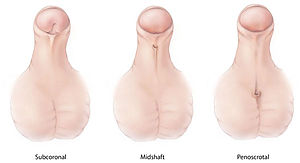Perineal hypospadias
| Hypospadias | |
|---|---|
 |
|
| Different types of hypospadias | |
| Pronunciation | |
| Classification and external resources | |
| Specialty | Urology, medical genetics |
| ICD-10 | Q54 |
| ICD-9-CM | 752.61 |
| DiseasesDB | 29907 |
| MedlinePlus | 001286 |
| eMedicine | ped/1136 |
Hypospadias is a congenital disorder of the urethra where the urinary opening is not at the usual location on the head of the penis. It is the second-most common birth abnormality of the male reproductive system, affecting about one of every 250 males at birth. In roughly 90% of cases, the opening (meatus) is on or near the head of the penis (glans), referred to as distal hypospadias, while the remainder have proximal hypospadias with a meatus near or within the scrotum. Shiny tissue seen extending from the meatus to the tip of the glans, which would have made the urinary channel, is referred to as the urethral plate.
In most cases, the foreskin is also underdeveloped and does not wrap completely around the penis, leaving the underside of the glans penis uncovered. Also, a downward bending of the penis, commonly referred to as chordee, may occur. This is found in 10% of distal hypospadias and 50% of proximal hypospadias at the time of surgery. The scrotum may be higher than usual to either side of the penis, called penoscrotal transposition, adding to the abnormal overall appearance.
Hypospadias is thought to result from failure of the urinary channel to completely tubularize to the end of the penis; the cause is not known. Most often, it is the only abnormal finding, although in about 10% of cases, hypospadias may be part of a syndrome with multiple abnormalities.
The most common associated defect is an undescended testicle, which has been reported in around 3% of infants with distal hypospadias and 10% of those having proximal hypospadias. The combination of hypospadias and an undescended testicle sometimes indicates a disorder of sexual differentiation, and so additional testing may be recommended. Otherwise no blood tests or X-rays are routinely needed in newborns with hypospadias.
Hypospadias can be a symptom or indication of an intersex condition but the presence of hypospadias alone is not enough to classify as intersex. In most cases, hypospadias is not associated with any condition.
Hypospadias is usually diagnosed in the newborn nursery by the characteristic appearance of the penis. The urinary opening (“meatus”) is lower than normal, and most children have only partial development of the foreskin, lacking the normal covering for the glans on the underside. The abnormal “hooded” foreskin calls attention to the condition. However, not all newborns with partial foreskin development have hypospadias, as some have a normal urinary opening with a hooded foreskin, which is called “chordee without hypospadias”.
...
Wikipedia
